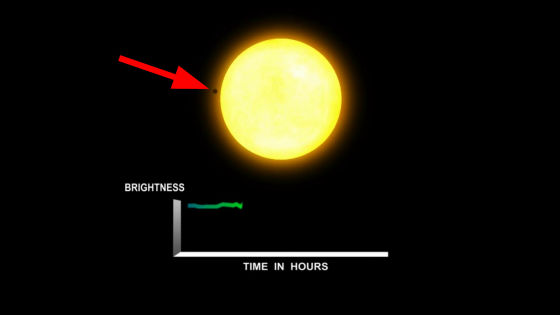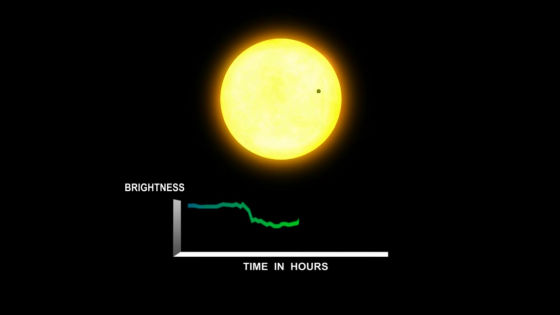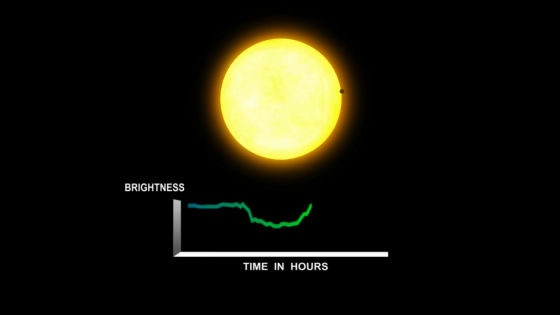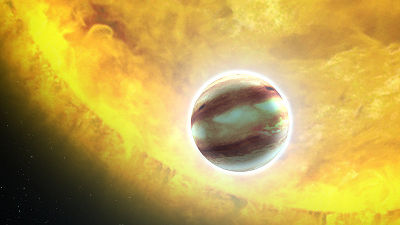Kepler Space Telescope newly discovered 1284 extrasolar planets, 9 of which are likely to exist life forms

NASA'sKeplerThe Space Telescope has discovered a total of 1284 planets. This is a great achievement that doubles the number of extrasolar planets that have been found so far, and it is pointed out that it is a big discovery for space science, such as the possibility that there are far more planets than previously thought It is.
Briefing Materials: 1,284 Newly Validated Kepler Planets | NASA
http://www.nasa.gov/feature/ames/kepler/briefingmaterials160510
The Kepler Space Telescope uses the "transit method" of discovering the planet by capturing a slight change in the amount of light seen when the planet traverses the star, the main star. You can easily understand the mechanism of planet detection by the transit method by looking at the following movie.
Transit graph - YouTube
A small "black dot" approaching a star that emits light is a planet. The graph below shows the change of the brightness of a star with time.

When a planet crosses a fixed star, the brightness (light intensity) of the detected star has decreased.

The decrease in light intensity continues as the planet traverses.

And when the planet completes traversal, the light intensity returns again. The transit method detects the planet by capturing the periodic decrease in the amount of light caused by a planet orbiting around a fixed star.

Of course, there may be loss of light intensity due to some object in the universe besides the planet.

Therefore, the data of the light quantity change detected by the Kepler Space Telescope is also checked against the gravity change measured by the ground and the image analysis result, and it is judged whether it is a planet or a pseudo-planet.

Thus, from the total 4302 celestial bodies discovered by the Kepler Space Telescope, 1284 celestial bodies that can be concluded to be a planet with 99% or more accuracy were found.

This is a graph showing the number of extrasolar planets found after 1995. The ocher color represents a new planet discovered by the Kepler Space Telescope this time, a new planet which the light blue color was discovered by the Kepler Space Telescope in the past, and the blue color is a new planet discovered by equipment other than the Kepler Space Telescope. From the graph, we can see that the Kepler Space Telescope discovered most of the extrasolar planets, this time the discovery is the largest planet detection case ever.

This is plotted for each size (vertical axis) and brightness (horizontal axis) of the discovered planet. The vertical axis represents the size compared to the earth, and the larger the number, the larger the size of the planet. The horizontal axis shows that the planet is more bright as going to the left. The planet (orange) discovered by the Kepler Space Telescope compared to the planet (blue) discovered from the ground is more in the right and lower area of the graph, so many of the small and blurred detectable planets are kepler It can be said that the space telescope is capturing it.

This time, the breakdown of planets and planet candidates outside the solar system discovered by Kepler Space Telescope looks like this. There are 1284 pieces judged to be planets with a degree of accuracy of 99% or more, 707 pieces judged not to be planets, and 1327 pieces not declared as planets because they are not sure over 99% I will. In addition, it seems that the Kepler Space Telescope has also detected firmly for 984 already known planets.

In this graph, the vertical axis represents the number and the horizontal axis represents the size of the planet. Orange color is the new planet that was discovered this time, the blue is a known planet. You can see that there are many planets of "Super-Earth-size" whose diameter is 1.2 times to 1.9 times the earth, "Sub-Neptune-size" 1.9 times to 3.1 times.

Of the 1284 newly discovered planets discovered this time, 550 are rock planets like the Earth. Furthermore, it was found that nine of them were present in the "habitable zone" where living organisms could survive because liquid water is present at a moderate distance from the stars and on the surface of the earth. That is, there are nine new planets with the possibility of existence of life forms.
About 2,300 of the 3000 extrasolar planets that have been found so far were discovered by the Kepler Space Telescope and the role Kepler Space Telescope has played in discovering the planet is enormously large. "I did not know how many planets outside the solar system existed until the Kepler Space Telescope appeared, but thanks to the Kepler telescope, the planet could be more than a star," said Paul Hertz of NASA I know that it is possible. "
Although the Kepler Space Telescope has had a great deal of achievement in planet discovery, NASA announced in 2018 that the satellite succeeding KeplerTESSIt is a plan to launch.

Related Posts:







